Case Study: Negligence Liability in Halifax Crash Landing, 2019
VerifiedAdded on 2022/09/09
|8
|1785
|17
Case Study
AI Summary
This case study analyzes a negligence claim stemming from the Halifax crash landing involving Air Canada, based on a news report. The assignment meticulously dissects the elements of negligence, including duty of care, breach of duty, and damage, referencing relevant legal precedents and applying them to the case facts. It identifies potential plaintiffs and defendants, such as the airline and aircraft manufacturers, and evaluates the concept of reasonable foresight and proximity in establishing liability. Furthermore, the analysis explores possible defenses that the defendants could employ, like exclusion clauses or demonstrating adherence to precautionary measures, providing a comprehensive overview of the legal complexities involved in such incidents. The document provides a detailed examination of the legal arguments and potential outcomes.
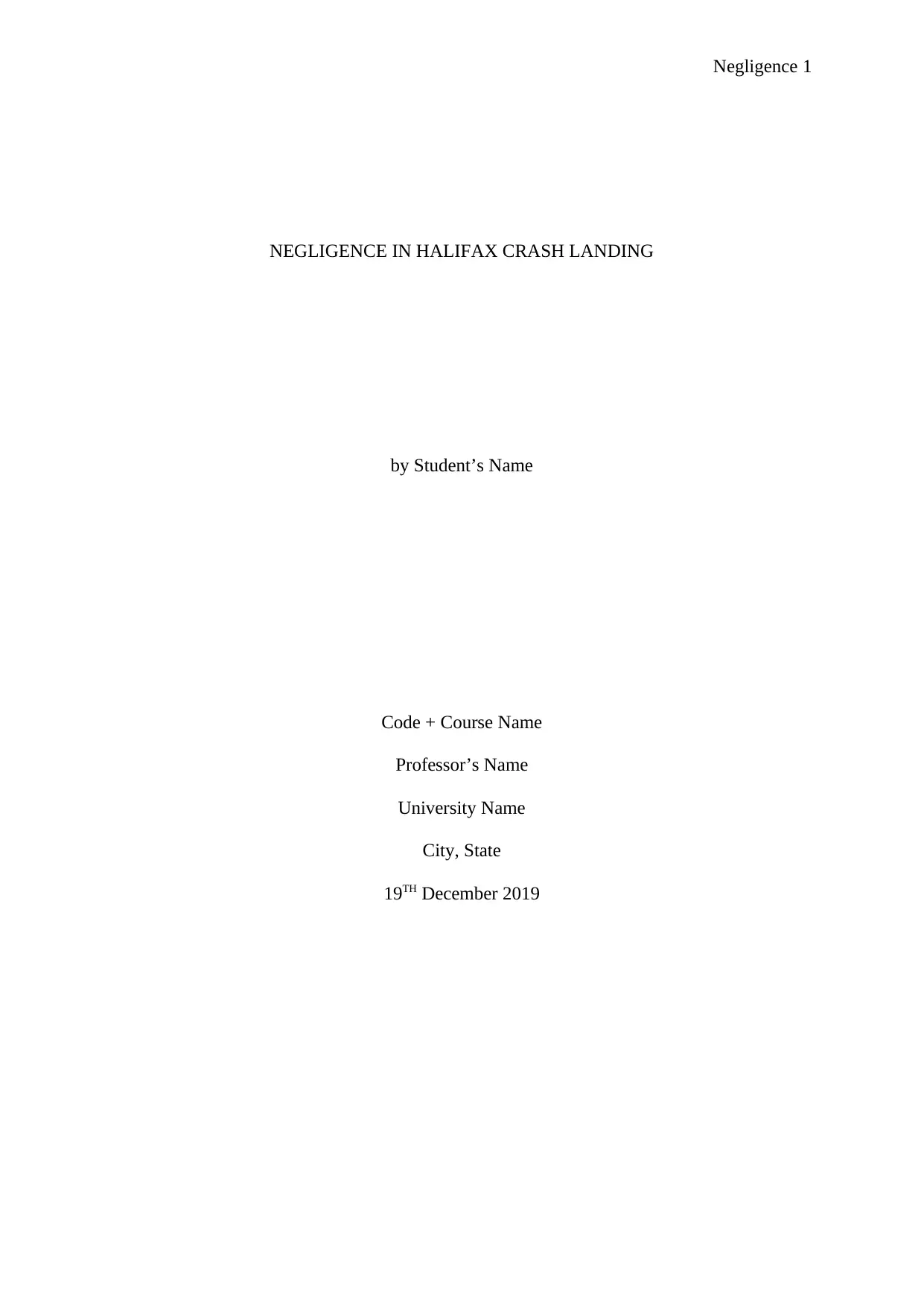
Negligence 1
NEGLIGENCE IN HALIFAX CRASH LANDING
by Student’s Name
Code + Course Name
Professor’s Name
University Name
City, State
19TH December 2019
NEGLIGENCE IN HALIFAX CRASH LANDING
by Student’s Name
Code + Course Name
Professor’s Name
University Name
City, State
19TH December 2019
Paraphrase This Document
Need a fresh take? Get an instant paraphrase of this document with our AI Paraphraser
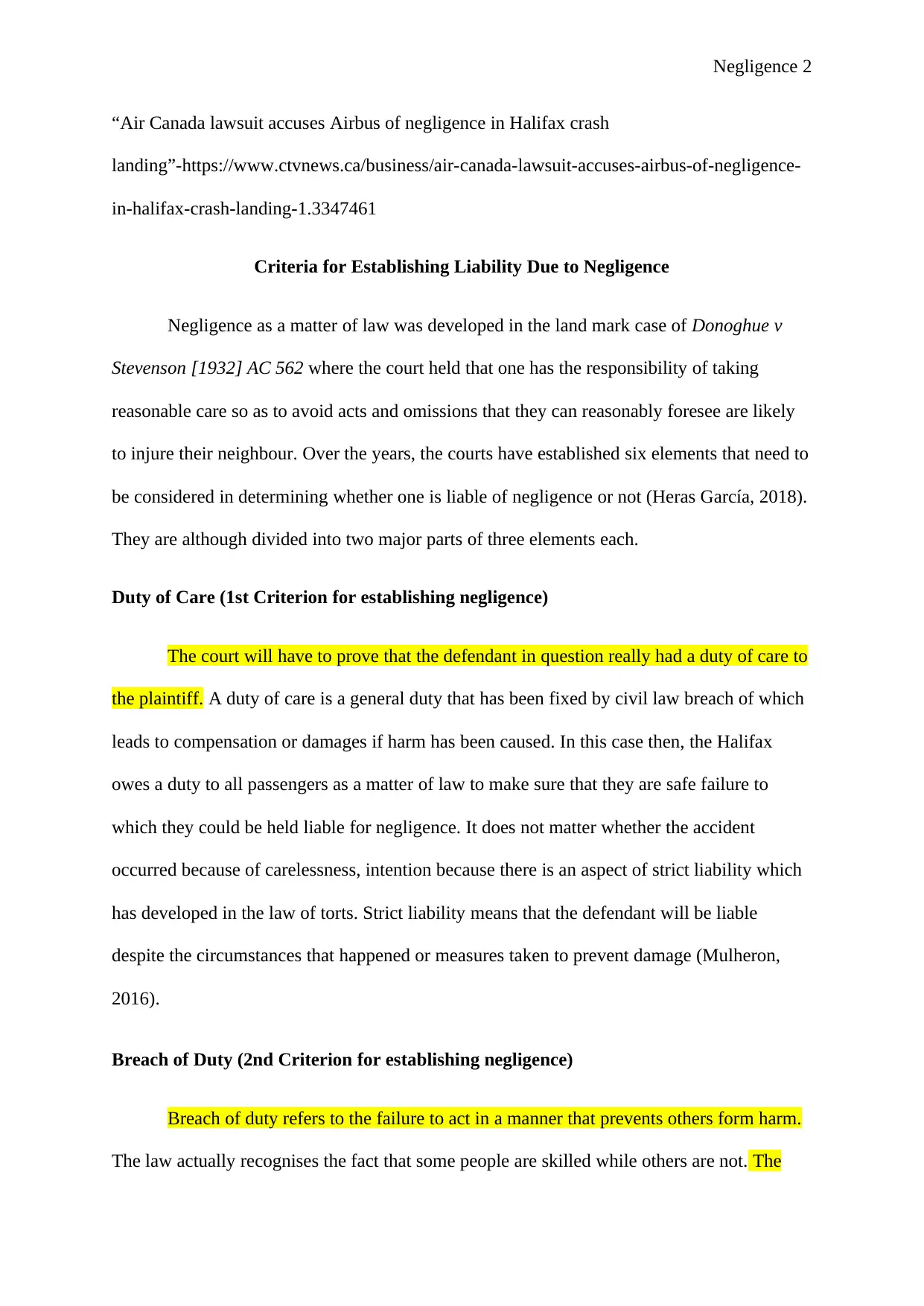
Negligence 2
“Air Canada lawsuit accuses Airbus of negligence in Halifax crash
landing”-https://www.ctvnews.ca/business/air-canada-lawsuit-accuses-airbus-of-negligence-
in-halifax-crash-landing-1.3347461
Criteria for Establishing Liability Due to Negligence
Negligence as a matter of law was developed in the land mark case of Donoghue v
Stevenson [1932] AC 562 where the court held that one has the responsibility of taking
reasonable care so as to avoid acts and omissions that they can reasonably foresee are likely
to injure their neighbour. Over the years, the courts have established six elements that need to
be considered in determining whether one is liable of negligence or not (Heras García, 2018).
They are although divided into two major parts of three elements each.
Duty of Care (1st Criterion for establishing negligence)
The court will have to prove that the defendant in question really had a duty of care to
the plaintiff. A duty of care is a general duty that has been fixed by civil law breach of which
leads to compensation or damages if harm has been caused. In this case then, the Halifax
owes a duty to all passengers as a matter of law to make sure that they are safe failure to
which they could be held liable for negligence. It does not matter whether the accident
occurred because of carelessness, intention because there is an aspect of strict liability which
has developed in the law of torts. Strict liability means that the defendant will be liable
despite the circumstances that happened or measures taken to prevent damage (Mulheron,
2016).
Breach of Duty (2nd Criterion for establishing negligence)
Breach of duty refers to the failure to act in a manner that prevents others form harm.
The law actually recognises the fact that some people are skilled while others are not. The
“Air Canada lawsuit accuses Airbus of negligence in Halifax crash
landing”-https://www.ctvnews.ca/business/air-canada-lawsuit-accuses-airbus-of-negligence-
in-halifax-crash-landing-1.3347461
Criteria for Establishing Liability Due to Negligence
Negligence as a matter of law was developed in the land mark case of Donoghue v
Stevenson [1932] AC 562 where the court held that one has the responsibility of taking
reasonable care so as to avoid acts and omissions that they can reasonably foresee are likely
to injure their neighbour. Over the years, the courts have established six elements that need to
be considered in determining whether one is liable of negligence or not (Heras García, 2018).
They are although divided into two major parts of three elements each.
Duty of Care (1st Criterion for establishing negligence)
The court will have to prove that the defendant in question really had a duty of care to
the plaintiff. A duty of care is a general duty that has been fixed by civil law breach of which
leads to compensation or damages if harm has been caused. In this case then, the Halifax
owes a duty to all passengers as a matter of law to make sure that they are safe failure to
which they could be held liable for negligence. It does not matter whether the accident
occurred because of carelessness, intention because there is an aspect of strict liability which
has developed in the law of torts. Strict liability means that the defendant will be liable
despite the circumstances that happened or measures taken to prevent damage (Mulheron,
2016).
Breach of Duty (2nd Criterion for establishing negligence)
Breach of duty refers to the failure to act in a manner that prevents others form harm.
The law actually recognises the fact that some people are skilled while others are not. The
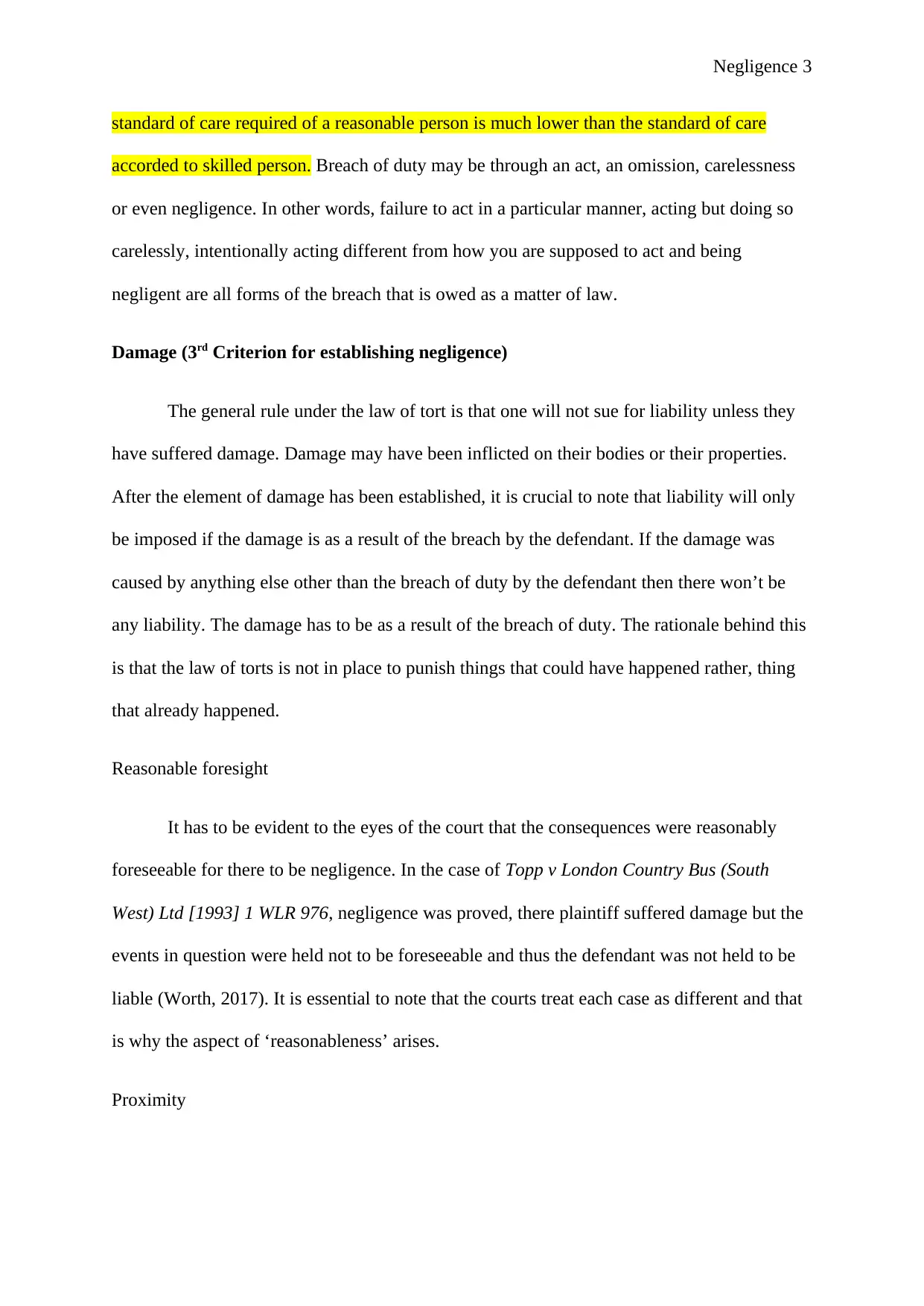
Negligence 3
standard of care required of a reasonable person is much lower than the standard of care
accorded to skilled person. Breach of duty may be through an act, an omission, carelessness
or even negligence. In other words, failure to act in a particular manner, acting but doing so
carelessly, intentionally acting different from how you are supposed to act and being
negligent are all forms of the breach that is owed as a matter of law.
Damage (3rd Criterion for establishing negligence)
The general rule under the law of tort is that one will not sue for liability unless they
have suffered damage. Damage may have been inflicted on their bodies or their properties.
After the element of damage has been established, it is crucial to note that liability will only
be imposed if the damage is as a result of the breach by the defendant. If the damage was
caused by anything else other than the breach of duty by the defendant then there won’t be
any liability. The damage has to be as a result of the breach of duty. The rationale behind this
is that the law of torts is not in place to punish things that could have happened rather, thing
that already happened.
Reasonable foresight
It has to be evident to the eyes of the court that the consequences were reasonably
foreseeable for there to be negligence. In the case of Topp v London Country Bus (South
West) Ltd [1993] 1 WLR 976, negligence was proved, there plaintiff suffered damage but the
events in question were held not to be foreseeable and thus the defendant was not held to be
liable (Worth, 2017). It is essential to note that the courts treat each case as different and that
is why the aspect of ‘reasonableness’ arises.
Proximity
standard of care required of a reasonable person is much lower than the standard of care
accorded to skilled person. Breach of duty may be through an act, an omission, carelessness
or even negligence. In other words, failure to act in a particular manner, acting but doing so
carelessly, intentionally acting different from how you are supposed to act and being
negligent are all forms of the breach that is owed as a matter of law.
Damage (3rd Criterion for establishing negligence)
The general rule under the law of tort is that one will not sue for liability unless they
have suffered damage. Damage may have been inflicted on their bodies or their properties.
After the element of damage has been established, it is crucial to note that liability will only
be imposed if the damage is as a result of the breach by the defendant. If the damage was
caused by anything else other than the breach of duty by the defendant then there won’t be
any liability. The damage has to be as a result of the breach of duty. The rationale behind this
is that the law of torts is not in place to punish things that could have happened rather, thing
that already happened.
Reasonable foresight
It has to be evident to the eyes of the court that the consequences were reasonably
foreseeable for there to be negligence. In the case of Topp v London Country Bus (South
West) Ltd [1993] 1 WLR 976, negligence was proved, there plaintiff suffered damage but the
events in question were held not to be foreseeable and thus the defendant was not held to be
liable (Worth, 2017). It is essential to note that the courts treat each case as different and that
is why the aspect of ‘reasonableness’ arises.
Proximity
⊘ This is a preview!⊘
Do you want full access?
Subscribe today to unlock all pages.

Trusted by 1+ million students worldwide
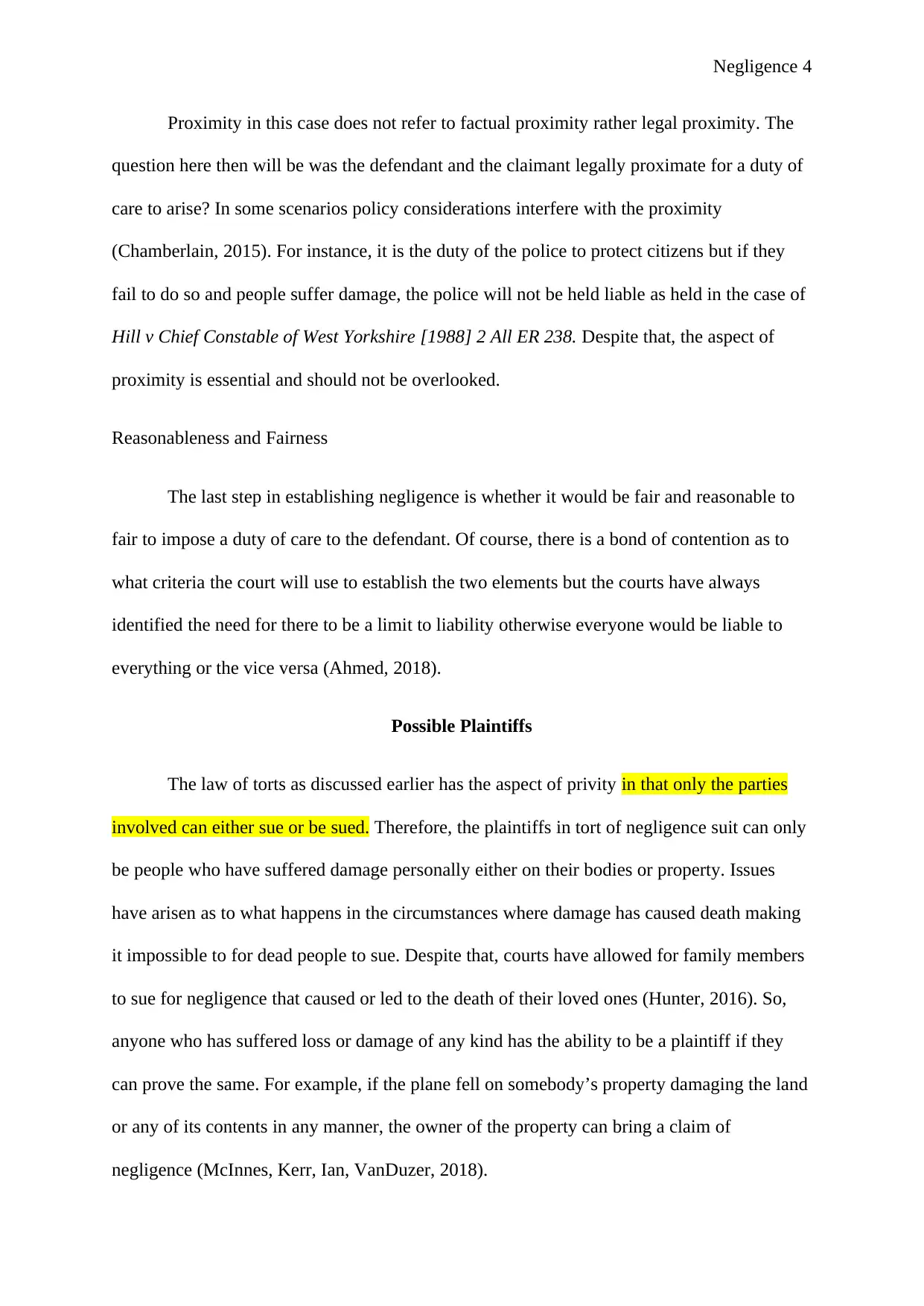
Negligence 4
Proximity in this case does not refer to factual proximity rather legal proximity. The
question here then will be was the defendant and the claimant legally proximate for a duty of
care to arise? In some scenarios policy considerations interfere with the proximity
(Chamberlain, 2015). For instance, it is the duty of the police to protect citizens but if they
fail to do so and people suffer damage, the police will not be held liable as held in the case of
Hill v Chief Constable of West Yorkshire [1988] 2 All ER 238. Despite that, the aspect of
proximity is essential and should not be overlooked.
Reasonableness and Fairness
The last step in establishing negligence is whether it would be fair and reasonable to
fair to impose a duty of care to the defendant. Of course, there is a bond of contention as to
what criteria the court will use to establish the two elements but the courts have always
identified the need for there to be a limit to liability otherwise everyone would be liable to
everything or the vice versa (Ahmed, 2018).
Possible Plaintiffs
The law of torts as discussed earlier has the aspect of privity in that only the parties
involved can either sue or be sued. Therefore, the plaintiffs in tort of negligence suit can only
be people who have suffered damage personally either on their bodies or property. Issues
have arisen as to what happens in the circumstances where damage has caused death making
it impossible to for dead people to sue. Despite that, courts have allowed for family members
to sue for negligence that caused or led to the death of their loved ones (Hunter, 2016). So,
anyone who has suffered loss or damage of any kind has the ability to be a plaintiff if they
can prove the same. For example, if the plane fell on somebody’s property damaging the land
or any of its contents in any manner, the owner of the property can bring a claim of
negligence (McInnes, Kerr, Ian, VanDuzer, 2018).
Proximity in this case does not refer to factual proximity rather legal proximity. The
question here then will be was the defendant and the claimant legally proximate for a duty of
care to arise? In some scenarios policy considerations interfere with the proximity
(Chamberlain, 2015). For instance, it is the duty of the police to protect citizens but if they
fail to do so and people suffer damage, the police will not be held liable as held in the case of
Hill v Chief Constable of West Yorkshire [1988] 2 All ER 238. Despite that, the aspect of
proximity is essential and should not be overlooked.
Reasonableness and Fairness
The last step in establishing negligence is whether it would be fair and reasonable to
fair to impose a duty of care to the defendant. Of course, there is a bond of contention as to
what criteria the court will use to establish the two elements but the courts have always
identified the need for there to be a limit to liability otherwise everyone would be liable to
everything or the vice versa (Ahmed, 2018).
Possible Plaintiffs
The law of torts as discussed earlier has the aspect of privity in that only the parties
involved can either sue or be sued. Therefore, the plaintiffs in tort of negligence suit can only
be people who have suffered damage personally either on their bodies or property. Issues
have arisen as to what happens in the circumstances where damage has caused death making
it impossible to for dead people to sue. Despite that, courts have allowed for family members
to sue for negligence that caused or led to the death of their loved ones (Hunter, 2016). So,
anyone who has suffered loss or damage of any kind has the ability to be a plaintiff if they
can prove the same. For example, if the plane fell on somebody’s property damaging the land
or any of its contents in any manner, the owner of the property can bring a claim of
negligence (McInnes, Kerr, Ian, VanDuzer, 2018).
Paraphrase This Document
Need a fresh take? Get an instant paraphrase of this document with our AI Paraphraser
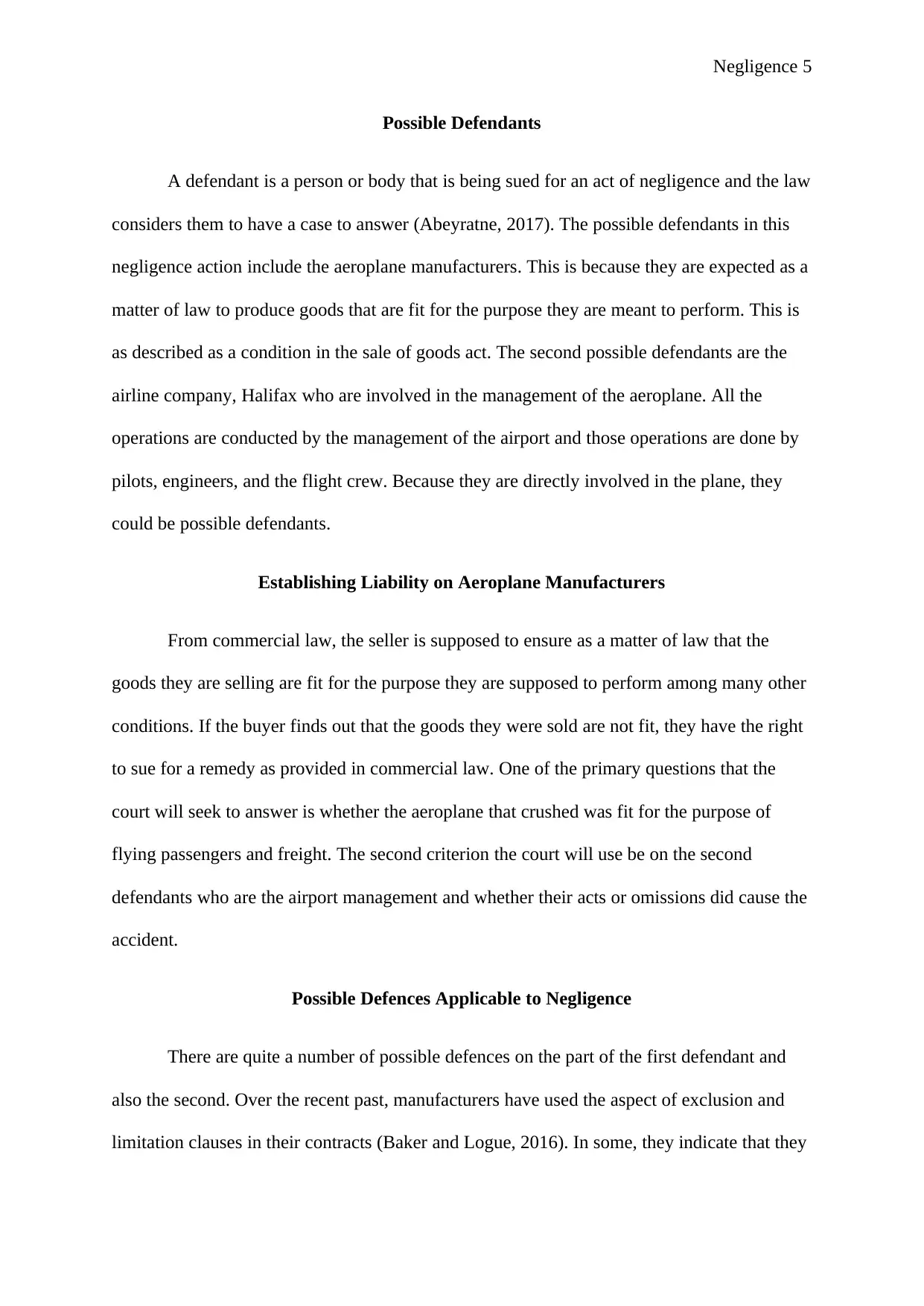
Negligence 5
Possible Defendants
A defendant is a person or body that is being sued for an act of negligence and the law
considers them to have a case to answer (Abeyratne, 2017). The possible defendants in this
negligence action include the aeroplane manufacturers. This is because they are expected as a
matter of law to produce goods that are fit for the purpose they are meant to perform. This is
as described as a condition in the sale of goods act. The second possible defendants are the
airline company, Halifax who are involved in the management of the aeroplane. All the
operations are conducted by the management of the airport and those operations are done by
pilots, engineers, and the flight crew. Because they are directly involved in the plane, they
could be possible defendants.
Establishing Liability on Aeroplane Manufacturers
From commercial law, the seller is supposed to ensure as a matter of law that the
goods they are selling are fit for the purpose they are supposed to perform among many other
conditions. If the buyer finds out that the goods they were sold are not fit, they have the right
to sue for a remedy as provided in commercial law. One of the primary questions that the
court will seek to answer is whether the aeroplane that crushed was fit for the purpose of
flying passengers and freight. The second criterion the court will use be on the second
defendants who are the airport management and whether their acts or omissions did cause the
accident.
Possible Defences Applicable to Negligence
There are quite a number of possible defences on the part of the first defendant and
also the second. Over the recent past, manufacturers have used the aspect of exclusion and
limitation clauses in their contracts (Baker and Logue, 2016). In some, they indicate that they
Possible Defendants
A defendant is a person or body that is being sued for an act of negligence and the law
considers them to have a case to answer (Abeyratne, 2017). The possible defendants in this
negligence action include the aeroplane manufacturers. This is because they are expected as a
matter of law to produce goods that are fit for the purpose they are meant to perform. This is
as described as a condition in the sale of goods act. The second possible defendants are the
airline company, Halifax who are involved in the management of the aeroplane. All the
operations are conducted by the management of the airport and those operations are done by
pilots, engineers, and the flight crew. Because they are directly involved in the plane, they
could be possible defendants.
Establishing Liability on Aeroplane Manufacturers
From commercial law, the seller is supposed to ensure as a matter of law that the
goods they are selling are fit for the purpose they are supposed to perform among many other
conditions. If the buyer finds out that the goods they were sold are not fit, they have the right
to sue for a remedy as provided in commercial law. One of the primary questions that the
court will seek to answer is whether the aeroplane that crushed was fit for the purpose of
flying passengers and freight. The second criterion the court will use be on the second
defendants who are the airport management and whether their acts or omissions did cause the
accident.
Possible Defences Applicable to Negligence
There are quite a number of possible defences on the part of the first defendant and
also the second. Over the recent past, manufacturers have used the aspect of exclusion and
limitation clauses in their contracts (Baker and Logue, 2016). In some, they indicate that they
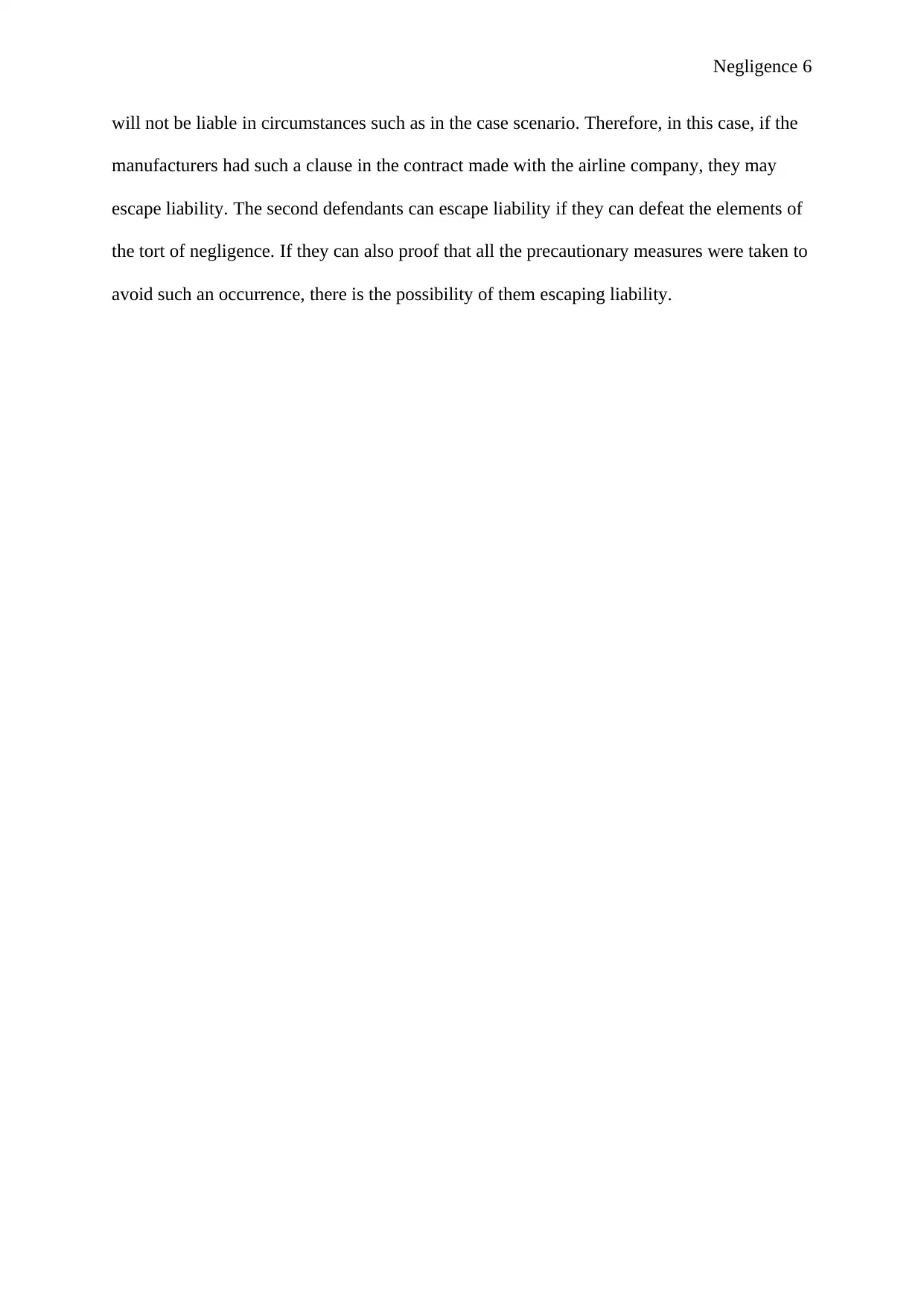
Negligence 6
will not be liable in circumstances such as in the case scenario. Therefore, in this case, if the
manufacturers had such a clause in the contract made with the airline company, they may
escape liability. The second defendants can escape liability if they can defeat the elements of
the tort of negligence. If they can also proof that all the precautionary measures were taken to
avoid such an occurrence, there is the possibility of them escaping liability.
will not be liable in circumstances such as in the case scenario. Therefore, in this case, if the
manufacturers had such a clause in the contract made with the airline company, they may
escape liability. The second defendants can escape liability if they can defeat the elements of
the tort of negligence. If they can also proof that all the precautionary measures were taken to
avoid such an occurrence, there is the possibility of them escaping liability.
⊘ This is a preview!⊘
Do you want full access?
Subscribe today to unlock all pages.

Trusted by 1+ million students worldwide
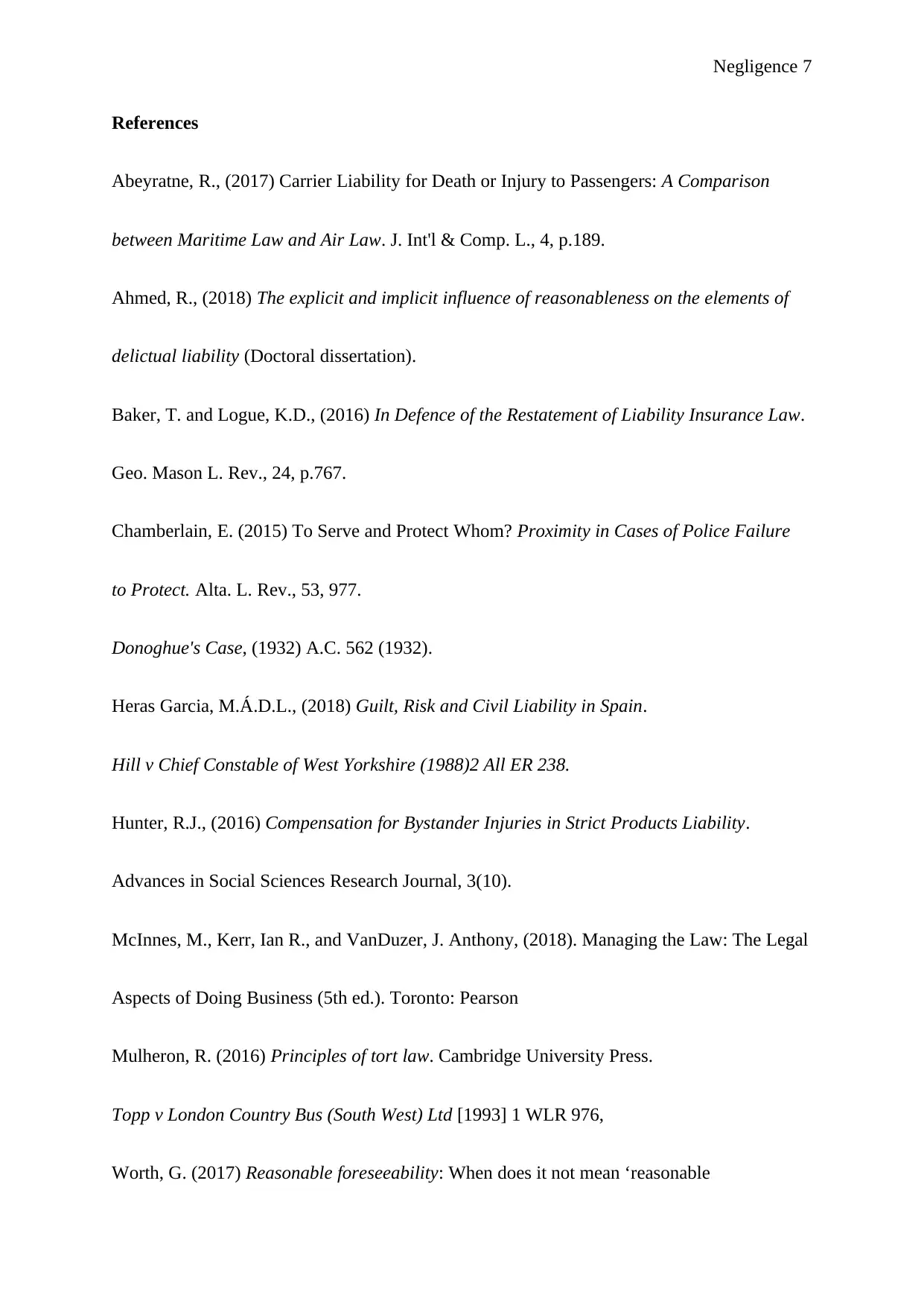
Negligence 7
References
Abeyratne, R., (2017) Carrier Liability for Death or Injury to Passengers: A Comparison
between Maritime Law and Air Law. J. Int'l & Comp. L., 4, p.189.
Ahmed, R., (2018) The explicit and implicit influence of reasonableness on the elements of
delictual liability (Doctoral dissertation).
Baker, T. and Logue, K.D., (2016) In Defence of the Restatement of Liability Insurance Law.
Geo. Mason L. Rev., 24, p.767.
Chamberlain, E. (2015) To Serve and Protect Whom? Proximity in Cases of Police Failure
to Protect. Alta. L. Rev., 53, 977.
Donoghue's Case, (1932) A.C. 562 (1932).
Heras Garcia, M.Á.D.L., (2018) Guilt, Risk and Civil Liability in Spain.
Hill v Chief Constable of West Yorkshire (1988)2 All ER 238.
Hunter, R.J., (2016) Compensation for Bystander Injuries in Strict Products Liability.
Advances in Social Sciences Research Journal, 3(10).
McInnes, M., Kerr, Ian R., and VanDuzer, J. Anthony, (2018). Managing the Law: The Legal
Aspects of Doing Business (5th ed.). Toronto: Pearson
Mulheron, R. (2016) Principles of tort law. Cambridge University Press.
Topp v London Country Bus (South West) Ltd [1993] 1 WLR 976,
Worth, G. (2017) Reasonable foreseeability: When does it not mean ‘reasonable
References
Abeyratne, R., (2017) Carrier Liability for Death or Injury to Passengers: A Comparison
between Maritime Law and Air Law. J. Int'l & Comp. L., 4, p.189.
Ahmed, R., (2018) The explicit and implicit influence of reasonableness on the elements of
delictual liability (Doctoral dissertation).
Baker, T. and Logue, K.D., (2016) In Defence of the Restatement of Liability Insurance Law.
Geo. Mason L. Rev., 24, p.767.
Chamberlain, E. (2015) To Serve and Protect Whom? Proximity in Cases of Police Failure
to Protect. Alta. L. Rev., 53, 977.
Donoghue's Case, (1932) A.C. 562 (1932).
Heras Garcia, M.Á.D.L., (2018) Guilt, Risk and Civil Liability in Spain.
Hill v Chief Constable of West Yorkshire (1988)2 All ER 238.
Hunter, R.J., (2016) Compensation for Bystander Injuries in Strict Products Liability.
Advances in Social Sciences Research Journal, 3(10).
McInnes, M., Kerr, Ian R., and VanDuzer, J. Anthony, (2018). Managing the Law: The Legal
Aspects of Doing Business (5th ed.). Toronto: Pearson
Mulheron, R. (2016) Principles of tort law. Cambridge University Press.
Topp v London Country Bus (South West) Ltd [1993] 1 WLR 976,
Worth, G. (2017) Reasonable foreseeability: When does it not mean ‘reasonable
Paraphrase This Document
Need a fresh take? Get an instant paraphrase of this document with our AI Paraphraser
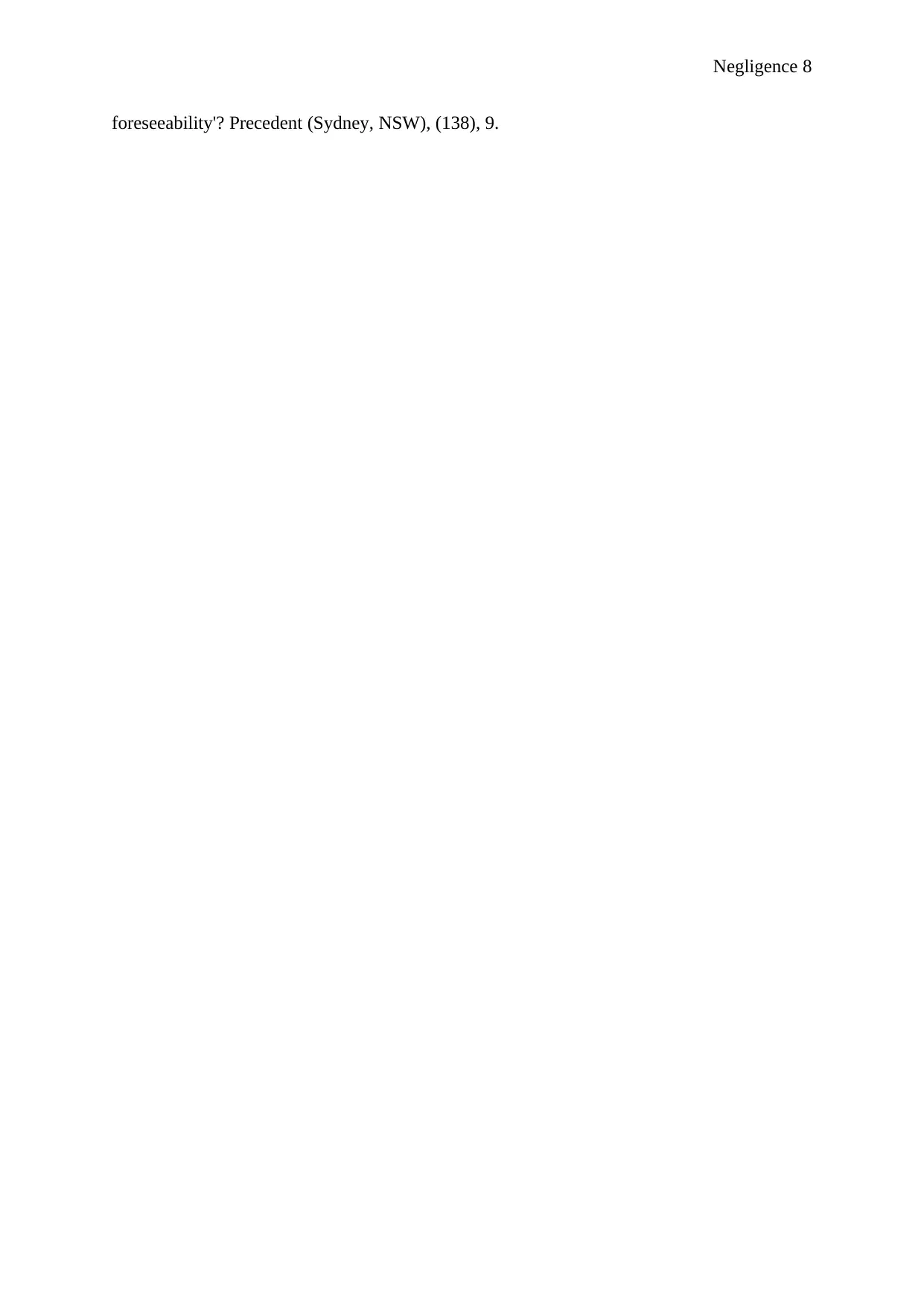
Negligence 8
foreseeability'? Precedent (Sydney, NSW), (138), 9.
foreseeability'? Precedent (Sydney, NSW), (138), 9.
1 out of 8
Related Documents
Your All-in-One AI-Powered Toolkit for Academic Success.
+13062052269
info@desklib.com
Available 24*7 on WhatsApp / Email
![[object Object]](/_next/static/media/star-bottom.7253800d.svg)
Unlock your academic potential
Copyright © 2020–2025 A2Z Services. All Rights Reserved. Developed and managed by ZUCOL.




